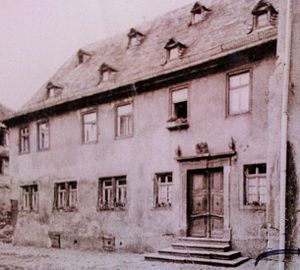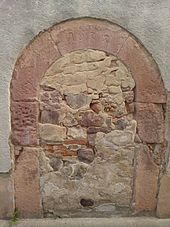Gans'scher Adelshof
| Gans'scher Adelshof | ||
|---|---|---|
|
East wing of the mansion on an old view |
||
| Alternative name (s): | Praunheim'scher Hof, Gans von Otzberg'scher Adelshof, Gans'scher Hof, Gans'sches Palais | |
| Creation time : | approx. 13th century. 1480 | |
| Castle type : | City castle, aristocratic seat | |
| Conservation status: | Adelshof that has been rebuilt several times | |
| Standing position : | gentry | |
| Place: | Groß-Umstadt | |
| Geographical location | 49 ° 52 '3.4 " N , 8 ° 55' 45.8" E | |
| Height: | 111 m above sea level NN | |
|
|
||
The Gans'sche Adelshof was an inner-city aristocratic residence in today's Groß-Umstadt , Darmstadt-Dieburg district , in Hesse . It is named after the noble family of the Goose von Otzberg , who owned numerous allodial and fiefdoms in the area and named themselves after the nearby Otzberg and its fortress , on which they were Burgmannen .
location
The aristocratic court was once located on the southeast corner of the city wall of the old Umstadt. It was one of the seven noble residences of the city in the Middle Ages, which were built within the fortifications of the old town at prominent points to secure the city. He was the only one in the south-eastern part of the old town, while all the other six aristocratic residences or castles were concentrated from the north-west to the north-east end of the city wall.
history
Its origin can only be documented in a document since the High Middle Ages . In 1263 the aristocratic seat was probably owned by Konrad Klebitz, in 1396 Henn, also Clebiz von Nalsbach , is called, who died in 1452 and was married to Margarethe von Frankenstein . In 1463 the daughter Margarethe Klebitz von Nalsbach married Contz von Habern for the first time . One of the two presumably brought the property into the marriage. In 1480, after Contz von Habern's death, she married Philipp von Bommersheim-Praunheim for the second time. His son Heylmann (also Heilmann) von Praunheim-Bommersheim, born in 1509, was married to Lucie Schad von Ostheim . He died on October 1, 1533 (or 1531). His legible epitaph is now in the town church of Umstadt. His son Jacob von Praunheim married Anna von Gemmingen in 1528 . From 1480 ownership can now be documented directly: the noble family of Praunheim-Bommersheim was the owner for eighty years . After Jacob von Praunheim's death on September 22, 1560, Anna married Melchior von Grorodt for the second time in 1561. She died in 1577. Anna's daughter from her first marriage and her husband Heinrich von Obentraut seem to have had no interest in the property.
The farm is documented again on May 1, 1575, when it is sold to the widow (née Groschlag zu Dieburg ) and children of the late Heinrich Schelm von Bergen .
From around 1600 to 1694, the patron saint of the aristocratic residence, the goose von Otzberg, who had other possessions on the market square, owned the property until it died out. Between 1592 and 1604 Adam Gans von Otzberg acquired the property and bequeathed it to his son Johann Pleickard, the last offspring of the Gans von Otzberg nobility, who died childless on May 25, 1694 at the proud age of 75. It found its place under the choir of the town church. His widow Maria Katharina Geyling von Altheim inherited his property .
This sold it on May 31, 1770 to Valentin Blum, Hofmann of Curti , who resided as officials of the Electoral Palatinate in the nearby Curti Castle .
Only ten years later, in 1780, the bourgeois branch Ganß, in the form of the brewery owner Georg Bernhard Ganß, acquired the farm and renovated the property, which it owned until the twentieth century. Until 1913, beer was brewed for the Umstädter Schwanenbrauerei in the former Adelshof .
Building description
The extensive former Adelshof has a two-winged mansion . It has the shape of an L facing east with the long side and north with the short side. The north-south facing west wing is considered to be the older. It is two-story with a gable roof . A vaulted portal leads into the spacious cellar at its front . It is crowned by an alliance coat of arms . One coat of arms is almost completely weathered, but is assigned to the von Gemmingen family . The other coat of arms shows the Praunheim-Bommersheim family . The longer east wing, oriented in a west-east direction, is a simple rectangle. The massive two-storey lower storey dates from the 16th century and has an upper storey made of plastered half-timbering that was completely renovated around 1780 . In the direction of the west wing there is a baroque rectangular entrance door, which is also decorated by a double coat of arms above the portal stone, but is not related to it. The heraldic right coat of arms is assigned to Hans Gans von Otzberg zu Habitzheim , the left one as the talking coat of arms of his wife, a Wildentin von Heckendorf , depicting a hedge or twigs.
The mighty three-storey barn , which is offset to the east in the courtyard and also leans against the city wall , consists of a brick basement made of red Odenwald sandstone and a half-timbered upper floor, and dates from the time the east wing was converted. Between the barn and the east wing of the manor house was the tower called Schrannenturm or Kleiner Blauer Hut , which probably belonged to the city wall . It is believed that it was used to store supplies. The tower, so named after its slate cover, was demolished in 1808. Two smaller contiguous outbuildings were leaned against the northern walling of the courtyard on today's Brunnengasse and were probably to be entered via the sandstone gate from 1524, which is now walled up.
- see more
View in west-east direction from the former Judengasse to the west wing of the manor house, which was leaned against the southern city wall and the course of which can still be seen here
Todays use
The property is now privately owned and cannot be visited.
Others
Stories have been kept up to our day that the manor house was connected to the buildings outside the city wall via an underground passage.
literature
- Rolf Müller (Ed.): Palaces, castles, old walls. Published by the Hessendienst der Staatskanzlei, Wiesbaden 1990, ISBN 3-89214-017-0 , p. 152 f.
- Wilhelm Sante Georg (Hrsg.): Handbook of the historical sites of Germany - Hessen. 3. Edition. Verlag Alfred Kröner, 1976, ISBN 3-520-27403-5 .
- Georg Dehio: Handbook of the German art monuments. Hessen II: Folkhard Cremer (arrangement): Darmstadt administrative district. 1st edition. Deutscher Kunstverlag, Munich / Berlin 2008, ISBN 978-3-422-03117-3 .
- Peter Schröck-Schmidt: The Adelshof goose from Otzberg. In: Magistrat der Stadt Groß-Umstadt (Ed.): 1250 years Groß-Umstadt 743-1993. Geiger-Verlag, Horb am Neckar 1993, ISBN 3-89264-771-2 , pp. 190-192.
- G. Brenner - a resident and his city. Essays on history. (= Autmundisstat series of publications. Special volume). 1st edition. Museum and History Association Groß-Umstadt , 2009, DNB 992693993 .
- Georg Brenner: The Gans'sche Adelshof zu Umstadt: Its history through 5 centuries. Odenwald Verlag, 1963.
Web links
Individual evidence
- ↑ A house through the ages - the Burgmannenhaus in Hering / Otzberg p. 11. ( Page no longer available , search in web archives ) Info: The link was automatically marked as defective. Please check the link according to the instructions and then remove this notice.
- ↑ The Klebitz (or Clebiz) of Nalsbach a low noble family from the northern Odenwald have been, probably named themselves after their possessions to Nalsbach, a village north of the modern large-Umstädter district just a few hundred meters Wiebelsbach lay in the Thirty Years' War desolate fell and was part of the Umstädter condominium . They are assigned the gender of the Odenwälder Bache , which was split into four families (cf. also Bacheburg and the story of the Bach von Rosenbach ) and correctly called Bach von Nalsbach called Clebiz (Klebitz). 1246 with Conradus Glebize, miles first documented, the family died out on March 5, 1573 with the death of Conrad Clebitz in Großwallstadt .
- ↑ partly P f called raunheim. Belonged to the von Praunheim family , his son took over the neighboring, unrelated Bommersheim coat of arms and merged it with the Frankfurt eagle.
- ^ Vizedom in Aschaffenburg, died July 20, 1578, 1882 epitaph in the collegiate church Aschaffenburg , after August Amrhein: The prelates and canons of the former collegiate monastery St. Peter and Alexander zu Aschaffenburg , Julius-Maximilians-Universität Würzburg 1882, p. 354; and information from the archive director of the City and Abbey Archives Aschaffenburg, December 2013.
- ↑ The name Grorodt appears in documents in various variations: Graenrodt, Grärodt, Gränrodt, Gränroth, Grorodt; as a result, the family relationships are still inaccurate to this day.
- ↑ 1882 bronze relief mentioned in the collegiate church Aschaffenburg , after August Amrhein: The prelates and canons of the former collegiate monastery St. Peter and Alexander zu Aschaffenburg , Julius-Maximilians-Universität Würzburg 1882, p. 354; and information from the archive director of the City and Abbey Archives Aschaffenburg, December 2013; Image of the relief
- ↑ G. Brenner - a resident and his city. Essays on history. (= Autmundisstat series of publications. Special volume). Ed. Museum and History Association Groß-Umstadt , 1st edition. 2009, p. 18.











